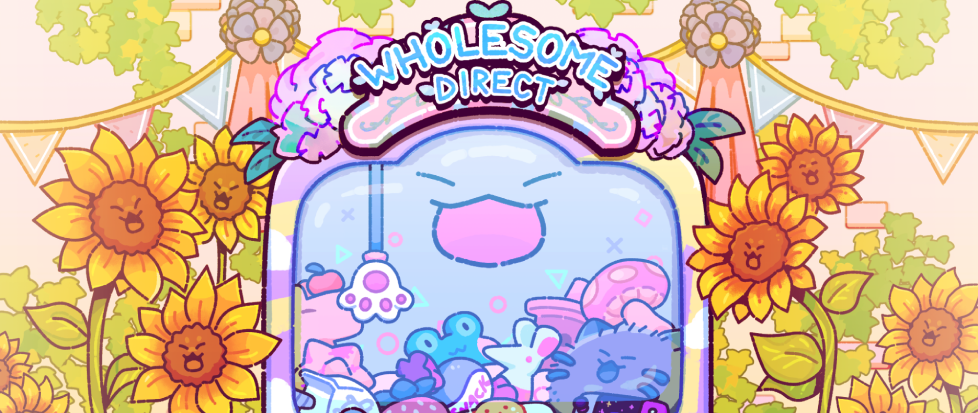
What Does it Mean to be Wholesome in 2023: An Analysis of the 2023 Wholesome Direct
The Wholesome Direct is an online showcase of upcoming games curated under the loose idea of depicting a wholesome vibe. So what does it mean to be wholesome? The Wholesome Direct website is upfront that the definition of wholesome in relation to games is subjective. The FAQ suggests wholesome games are ones that evoke comfort, compassion and coziness as well as making reference to games that are uplifting, thoughtful and hopeful. These terms speak to intent but not content, and while “vibes” is a perfectly valid method of curation there is value in seeing what elements these vibes are constructed with. If the vibe of a game is an intangible something greater than the sum of its parts we have 78 examples from the wholesome games showcased in this direct to at least sum the parts.
This article details a set of recurring images, features and aspects of the 2023 Wholesome Direct as a collective representation of wholesome games. The intention is not to critique individual games or creators but rather to provide a systematic look at the conception of “wholesomeness” in games. If you would like to read a similar analysis for the 2022 Wholesome Direct you can click here.
The direct itself is divided into three sections: a pre-show which featured trailers accompanied often by a short interview with the creators, the main show with trailers around 30 seconds to 1 minute in length with narration and sometimes a video appearance by the games creators and a final quick-shot section where multiple games are shown in rapid succession with no voiceover. All games featured in the showcase were examined for this analysis although this does mean that the games in the quick-shot section were explained in less detail.
To identify what are the recurring features of the games showcased I watched the direct three times through with a spreadsheet of every game appearing at the show. In my first viewing I noted down a few common features but largely took in the show as it aired. In the second viewing I scrolled through each trailer and built out my main list of features, then grouped them into categories with a final third detailed check of what features in each game. For a feature or aspect to be counted it must appear in more than one game unless otherwise stated.
For features that were counted I have endeavored to stick to quantifiable and clear examples. I have not considered more complex and cultural factors not because these are not important but because they are not able to be quickly identified in a short trailer. There is a great deal that could be explored in how this collection of games treats culture, gender, identity and sex but it is beyond the scope of this article.
This is also not an exhaustive list; indeed in my third viewing I noticed more features that I could have added. For example it was only on my third viewing where I realized that probably four or so games featured a llama or alpaca-style animal. There will be things I have missed and blind spots that I was not aware of but I present what I observed sincerely.
———
Categories and Analysis
Although I did not want to evaluate any game showcased on its technical or artistic qualities, a clear distinction can be made between games that have predominantly 2D or 3D visuals. It is taken for granted that games will have a visual element and across the broader gaming sphere this has often been split by 2D or 3D depictions. Classically this has represented a technological barrier either between old and new games or between game makers working with different budgets. As can be seen in the figure below, for the Wholesome Direct there were 36 3D games and 42 2D games. Within the Wholesome Direct there is equivalent value placed on 2D and 3D games.
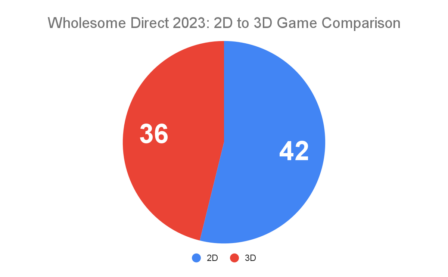
Figure 1: 2D to 3D Game Comparison
Who is Wholesome?
One finding from last year’s analysis of the Wholesome games showcase was that the vast majority of games presented a game in which you embody some form of living character. Again this year we see that Wholesome games largely center on a character or avatar that is either human or animal but there is also a sizable contingent of games with no character on the screen. These two perspectives, often referred to as third or first person games respectively, can convey different relations of the player to the game. Either you are an element within the game or a force acting upon the game, and there are also expectations associated with genres regarding the perspective of the player in relation to the game. The fourth category (Other) was composed of games where it was unclear what the players relationship is to the game or it was a character or form that did not comfortably equate to a human or animal. The distinction between first or third person shows a preference to games in the third person perspective, but what is more interesting is that the character represented is a human or animal with similar frequency.
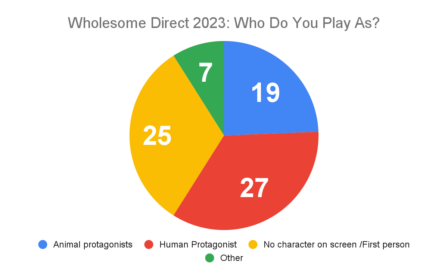
Figure 2: Who Do You Play As?
To expand upon this point we can look at the range of animals featured (not just those who are the player characters or protagonists). The first split in categorization of animals is if the games present animals as anthropomorphic or not. The number of games with human characters and anthropomorphic animals are listed in Figure 3. The way that animals are represented varies by game, there is a large proportion of animals given human characteristics. The distinction in this analysis between anthropomorphic or not is made on visual characteristics, e.g., is it apparent that the animal takes on a human-like form. In this categorization, an animal which talks but does not act as human is not considered anthropomorphic.
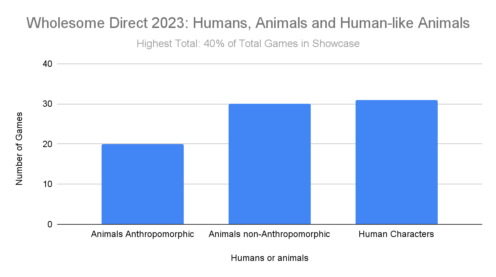
Figure 3: Humans, Animals and Human-like Animals
Sticking with animals as a point of interest, there is a range of animals and living things included. This analysis does not weigh the prominence within the trailer if it is merely present in any form. Mushrooms and birds are an example of living things with differing emphasis across trailers. Mushrooms caught my eye as opposed to the number of different crops or flowers in the game because of how they were featured. Birds also varied in their usage, some games had bird protagonists but many featured birds as an ambient aspect. The inclusion of birds in a location gives life to a scene and requires no further context as to how they got there or what they are doing; birds are allowed to just exist.
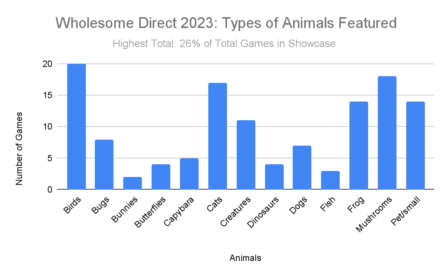
Figure 4: Types of Animals Featured
There are different hierarchies to how animals are used in the games, you might pet a capybara but you catch and eat fish. “Creatures” is a term used to cover any variety of animal or living thing not found in nature.
Where is Wholesome?
The next collection of features were related to the game’s environment. The presence of one of these features is not dependent on the other but many do overlap. To address a possible oversight upfront, a recurring environment that wasn’t captured in the list was a home or interior environment; if I was to do a fourth pass I would try to conceptualize this category in more detail. Continuing a theme seen in last year’s direct, games are frequently set in a town or small community with an abundance of trees often nestled between a coastline and some mountains. The geography constructed from these features reflect the scope of games in the showcase. Coastlines and mountains are natural borders and a wooded area fills up space in between, with these features a small town can become a world.
The environment also supports the common actions carried out in these games. Coastlines let you fish, mountains let you climb and forests provide resources for crafting. This is not to say that all environmental decisions were made for utilitarian reasons, there is a clear affinity for nature and the outdoors even if it is for one specific form of biome. One of the most striking aspects of the environments that these games use is that they are overwhelmingly set somewhere with a cool temperate atmosphere. When the Wholesome Direct aired it was during a hitherto unseasonable heatwave and it was inescapable to me how much these games want to present an experience of a world with a safe climate. Not every game directly addresses climate change or the environment but it will be impossible to make any games without considering climate in the future or have development not be impacted by changing climate. In the least charitable viewing of the frequent theme of a small community in a woodland I see an avoidance of climate change. I don’t believe it’s the responsibility of all games to show a future where everyone can live safely, but when I think of thoughtful or uplifting games, that is a vision I would like to see more of.
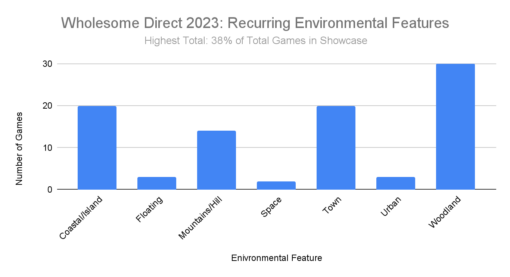
Figure 5: Recurring Environmental Features
What is Wholesome?
One of the primary drivers for conducting this analysis was to put some numbers to the perception that Wholesome games are a big collection of farming games. The frequency with which farming based games appear in the showcase makes a strong case that the direct views farming a wholesome activity. There are complex and important questions in relation to land use and food production as to the wholesomeness of farming but ultimately within the context of the Wholesome Direct, “wholesome” is a brand and not an arbiter of moral value. In its fourth year, with a sizable viewership, the Wholesome Direct is a place where people who make games with farming can connect with a specific audience.
The distinction between farming and gardening was normally made in the narration supporting the games themselves, but a definition I would apply on a more general basis is that farming is concerned with maximizing yield, and also encompasses animal husbandry, whilst gardening is the growing of plants for aesthetics or personal consumption. The scale of farming shown in the direct is more akin to a garden than massive tracts of land that require industrial machinery and a migrant labor force to function. The fantasy is not as a migrant laborer, it is as yeoman farmer, who owns their land and can support themselves and those around them. It is quite a conservative fantasy and again is something that I can’t avoid linking to climate change, where people would be drawn to a simulation of being able to own your own space and provide for themselves.
The amount of games which feature crafting are also linked to the fantasy of providing without the need for an industrial global supply chain. For a set of games with an affection for nature there is a lot of extraction taking place, and the justification must be that this is renewable at the level presented in these games. I don’t think players purposefully play these games with this mentality; the repetition, progression and communal aspects are what entice many players but these underlying themes remain present.
A companion to farming as a fantasy of ownership is the number of games where you run a small business. The game developers are largely small business owners themselves so I see why this would be a theme that resonates, and business management does provide some interesting mechanics and metrics to play with. I would however question if the activity being presented needs to have this ownership and capitalist layer.
Cooking and food preparation was also a very popular action, sometimes in the form of a business but mainly as a communal activity. This isn’t meant to diminish complicated relationships to food, but cooking is largely a humanitarian and activity of care that also is an excellent method of cultural exchange and relating personal experience. It is easy to see why this has become linked to wholesomeness. The way in which cooking is depicted frequently adopts rhythm mechanics which is also used for playing music in games. Something that works in parallel to cooking maybe without some of the stigmas of food is witchcraft and alchemy. Brewing cauldrons and casting spells is a power fantasy but also a profession with a set of practices.
Some of the other big themes are movement and the ability to traverse an environment in different ways, either by climbing, gliding or jumping etc. Customization and manipulation of the environment is also a recurring trend, one which operates at different scales from city, to a house to an object or character, customization is a valued trait. Classic gaming activities of driving and shooting are absent but combat does feature in some of the games.
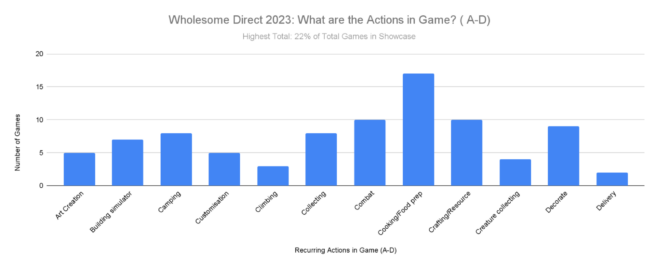
Figure 6: What are the Actions in Game? (A-D)
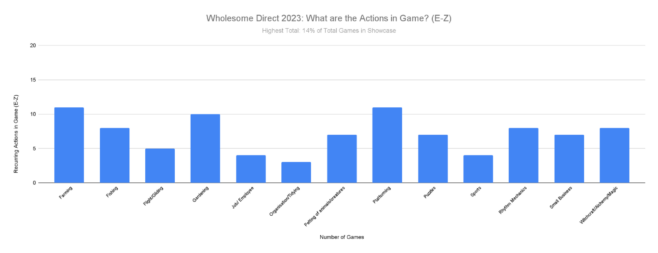
Figure 7: What are the Actions in Game? (E-Z)
There was one action that was not included in the above graphs, but if it had been it would be by the most frequently recurring item: conversation. Nearly half the games showcased a character speaking in their trailer. Speech can convey tone or style to the audience, but I also think that communicating and interacting with sentient characters is a fundamental part of the Wholesome Direct games. Of those that showed dialogue (written dialogue in all but one case), the number of times the player character also spoke was counted. In some instances the player character spoke from a set of dialogue options, but many times used what appeared to be predetermined lines. Customization of the player character was a more prominent feature than last year but this year’s games show a trend towards more authored content.
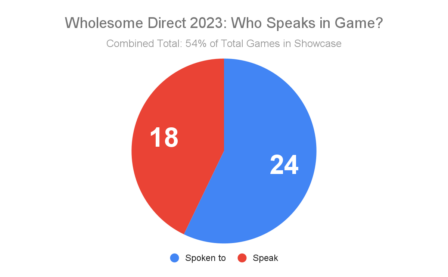
Figure 8: Who Speaks in Game?
When is Wholesome?
This was quite challenging to quantify, and in the process of classifying the terms I fluctuated between “genre” and “era,” but the final results do show a preference for the contemporary in the wholesome game showcase. The number of games that were assigned an era classification are not equal to the total games featured in the showcase so there are many games with no clear indicators for when the game is set.
The majority of wholesome games are set in the present, and rarely in the future. What constitutes the present is fluid but the presence of certain technologies, language and style paint a picture. Games set in a fantasy world or the past have clearer indicators as to the time period. Futuristic or sci-fi games were the outlier. In comparison to futuristic games, there are otherwise contemporaneous games which include some form of advanced technology but that do not tip into a distinct sci-fi category—this was a judgement call but even with the broadest application of “sci-fi” the results would not vary significantly. Recalling the conservative nature of the actions presented in these games, there does seem to be a missed opportunity to embrace the idea of wholesome games as hopeful by showing what the viewpoint from a more wholesome future might be.
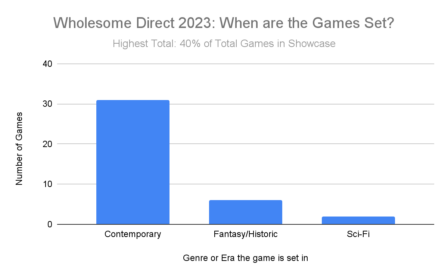
Figure 9: When are the Games set?
Wholesome Technology
Following from the number of contemporary games there were a few technological categories that were identified. What is and isn’t a “technology” can be debated, but a preference was given to electronic devices that were featured in the gameplay. If a character uses a phone this was counted, if there was a car in the background this was not counted, but would have been used to identify the game as contemporary.
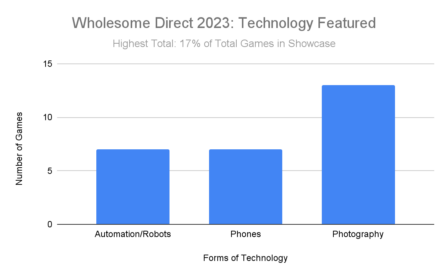
Figure 10: Technology Featured
The use of phones in games was interesting to me, as phones are a huge part of people’s lives but can often be a negative influence. Do games feature phones to replicate lived experiences, or avoid them to embrace an off-the-grid experience for the player? Automation and robots are elements I am personally interested in, and there is a tension between concerns about automation taking jobs or entrenching power structures and automation as liberatory technology to allow for an idealized small self-sufficient farming experience. Photography was also a common feature, either as an interface element in the games or an action that players take.
There is one instance of technology that could have fallen into this category that I didn’t find a satisfactory location for, which is wheelchairs. Probably four of five games showed a character in a wheelchair, I initially didn’t want to classify this as an indicator of disability because it did not reflect the full spectrum of disability and levels of visibility, but featuring a wheelchair speaks to a games intention to show inclusion. My tradeoff is to acknowledge it as a technology in this section and in future iterations would do a formal count.
Other objects, themes and curiosities
Beyond technologies and items that directly indicate an action there were a few items of interest that stood out to me. Campfires were a popular object which is in keeping with the prevalence of woodlands and the idea of coziness. Lighthouses and windmills were an interesting set of objects; both are tall structures that help add flavour and interest to the background. To my understanding, lighthouses are no longer critical infrastructure for seafaring but are evocative and link well to the coastal environments common to these games. The use of windmills correlated to games set in time periods where windmills were still regularly used although there were instances of modern power generating windmills. Windmills also serve a function of conveying the motion of the wind and adding movement to a static scene.
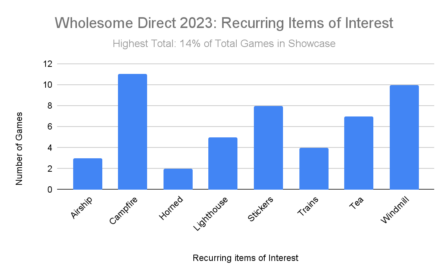
Figure 11: Recurring Items of Interest
There were a few games which focused on stickers as a mechanic but other games also adopted stickers as an aesthetic. Tea was a very common item, even mentioned in the interstitial material from the Wholesome Direct hosts. Tea fits with the food preparation and service themes seen across the showcase. Tea also has connotations of patience in the steeping process. The tea preparation shown follows more commonly in more Eastern and Asian forms of preparing tea and an interesting follow up analysis of the entire direct would be to examine Eastern and Western influences across the Wholesome Direct.
Assorted Recurring Themes and Features
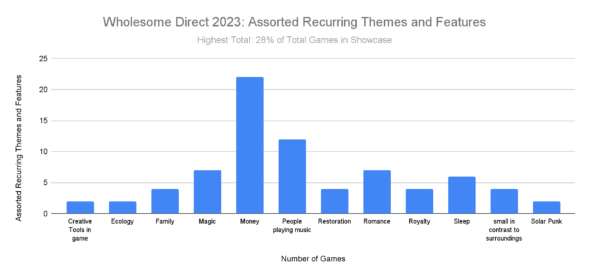
Figure 12: Assorted Recurring Themes and Features
The categories from this set that I would like to expand on are money, sleep and solarpunk. “Solarpunk” was a specific sub-genre that was explicitly mentioned in two different games in the showcase. Sleep was an interesting theme because under modern life’s pressures rest is aspirational. The inclusion of games featuring money as a category stemmed from the number of games featuring a small business. Money is a useful mechanic and scoring system as well as an inescapable part of contemporary life. I don’t necessarily think the inclusion of money in games means that a game is a glowing endorsement of capitalism but I would like to hope that the inclusion of monetary systems considers their wider implications.
Mechanics and Presentation
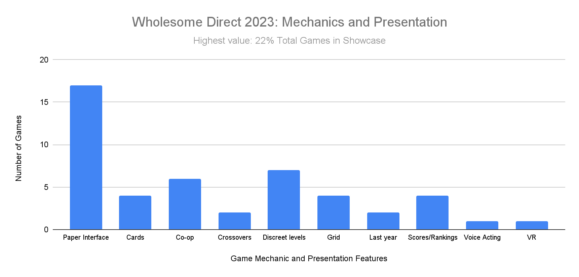
Figure 13: Mechanics and Presentation
The most frequent item in this grouping was the use of books or paper-style interfaces, representing typical game menus or inventories, most commonly in the form of a journal. Whilst the games are digital products there is perceived value in replicating analog forms.
Cards, co-op and grid-based games I hope are self-explanatory. “Discrete levels,” on the other hand, is a less clear term. I use it to reflect a style of game where the action is performed in a disconnected space, an example of which would be Captain Toad’s Treasure Tracker. This theme arose against a high number of games presenting an open world, although I was unable to quantify which games were explicitly so.
“Crossovers” is a category of note because it indicates that games can reference and build from the work done on games previously held up as wholesome. I included voice acting and Virtual Reality as categories despite having only one example each, because as exceptions they show the majority of games do not feature VR or voice acting.
Conclusions
So what does it mean to be “wholesome” in 2023? From this analysis Wholesome games would seem to be largely 2D or 3D spaces with an emphasis on nature, ownership and community in a contained safe environment. If you are making a game where you grow plants, cook food and share stories in a forest town by the coast then the wholesome showcase has an audience for you, and fundamentally the direct is about connecting game makers to players.
However,four years in, I think there is a risk of the showcase developing an ingrained set of values. A set of ideas that without critical reflection may give a conservative and narrow world view which I see most clearly in relation to climate. I am not interested in telling game makers and creators what they should make, but I would challenge them to consider what they include in their games and why. It’s a minor miracle that games get released at all and I don’t begrudge anyone who wishes to create something comfy and cozy, but I feel there is so much space to explore in wholesome games where we can look to the future as hopeful, thoughtful and uplifting.
———
Hilver is a UK-based researcher in a non-games related field. He likes making graphs and little models and can be found on twitter at @hilverofmars or @Hilver on Cohost.
———
Appendices
| Figure 1 | 2D | 42 |
| 3D | 36 | |
| Figure 2 | Animal protagonists | 19 |
| Human Protagonist | 27 | |
| No Character on Screen /First person | 25 | |
| Other | 7 | |
| Figure 3 | Animals Anthropomorphic | 20 |
| Animals non-Anthropomorphic | 30 | |
| Human Characters | 31 | |
| Figure 4 | Birds | 20 |
| Bugs | 8 | |
| Bunnies | 2 | |
| Butterflies | 4 | |
| Capybara | 5 | |
| Cats | 17 | |
| Creatures | 11 | |
| Dinosaurs | 4 | |
| Dogs | 7 | |
| Fish | 3 | |
| Frog | 14 | |
| Mushrooms | 18 | |
| Pet/Small Companion | 14 |
| Figure 5 | Coastal/Island | 20 |
| Floating Islands | 3 | |
| Mountains/Hills | 14 | |
| Space | 2 | |
| Town | 20 | |
| Urban | 3 | |
| Woodland | 30 | |
| Figure 6 | Art Creation | 5 |
| Building simulator | 7 | |
| Camping | 8 | |
| Customisation | 5 | |
| Climbing | 3 | |
| Collecting | 8 | |
| Combat | 10 | |
| Cooking/Food prep | 17 | |
| Crafting/Resource Harvesting | 10 | |
| Creature collecting | 4 | |
| Decorate | 9 | |
| Delivery | 2 | |
| Figure 7 | Farming | 11 |
| Fishing | 8 | |
| Flight/Gliding | 5 | |
| Gardening | 10 | |
| Job/ Employee | 4 | |
| Organisation/Tidying | 3 | |
| Petting of animals/creatures | 7 | |
| Platforming | 11 | |
| Puzzles | 7 | |
| Sports | 4 | |
| Rhythm Mechanics | 8 | |
| Small Business | 7 | |
| Witchcraft/Alchemy/Magic | 8 |
| Figure 8 | Spoken to | 24 |
| Speak | 18 | |
| Figure 9 | Contemporary | 31 |
| Fantasy/Historic | 6 | |
| Sci-Fi | 2 | |
| Figure 10 | Automation/Robots | 7 |
| Phones | 7 | |
| Photography | 13 | |
| Figure 11 | Airship | 3 |
| Campfire | 11 | |
| Horned Characters | 2 | |
| Lighthouse | 5 | |
| Stickers | 8 | |
| Trains | 4 | |
| Tea | 7 | |
| Windmill | 10 |
| Figure 12 | Creative Tools in Game | 2 |
| Ecology | 2 | |
| Family | 4 | |
| Magic | 7 | |
| Money | 22 | |
| People Playing Music | 12 | |
| Restoration | 4 | |
| Romance | 7 | |
| Royalty | 4 | |
| Sleep | 6 | |
| Small in Contrast to Surroundings | 4 | |
| Solar Punk | 2 | |
| Figure 13 | Books/Paper as Interface | 17 |
| Cards | 4 | |
| Co-op | 6 | |
| Crossovers | 2 | |
| Discreet levels | 7 | |
| Grid | 4 | |
| Last year | 2 | |
| Scores/Rankings/Stars | 4 | |
| Voice Acting | 1 | |
| VR | 1 |





